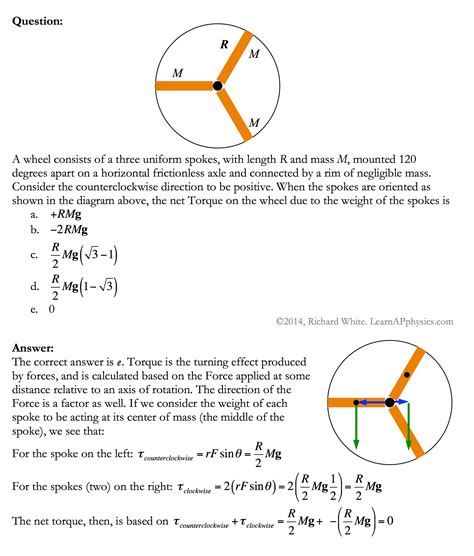Introduction
Circular motion is a fundamental concept in physics that describes the motion of an object moving in a circle at a constant speed. It is a common phenomenon observed in everyday life, from the movement of a spinning top to the rotation of the Earth around the Sun. Understanding circular motion is crucial for students taking AP Physics 1, as it forms the basis for many other concepts in physics, such as centripetal force, angular velocity, and acceleration.

Key Concepts
Centripetal Force
The centripetal force is the force that keeps an object moving in a circular path. It is always directed towards the center of the circle. For an object moving with a speed v at a radius r, the centripetal force (Fc) is given by:
Fc = mv^2 / r
where m is the mass of the object.
Angular Velocity
Angular velocity (ω) measures the rate at which an object rotates around an axis. It is defined as the angle (θ) swept out by the object per unit time (t):
ω = θ / t
Angular velocity is typically measured in radians per second (rad/s).
Acceleration
An object moving in a circular path experiences two types of acceleration: tangential acceleration and centripetal acceleration.
- Tangential acceleration is the component of acceleration that changes the speed of the object. It is directed tangent to the circle.
- Centripetal acceleration is the component of acceleration that changes the direction of the object’s motion. It is directed towards the center of the circle.
The total acceleration of an object moving in circular motion is:
a = √(a_t^2 + a_c^2)
Applications of Circular Motion
Circular motion has numerous practical applications in various fields, including:
- Engineering: Designing rotating machinery, such as engines, turbines, and pumps
- Transportation: Understanding the dynamics of vehicles on curves and circular tracks
- Sports: Analyzing the trajectory of projectiles, such as baseballs and basketballs
- Astronomy: Studying the motion of planets, stars, and galaxies
Benefits of Understanding Circular Motion
Understanding circular motion provides several benefits:
- Improved problem-solving skills: Circular motion problems often require students to apply multiple concepts simultaneously, enhancing their problem-solving abilities.
- Stronger foundation for further physics topics: Circular motion forms the foundation for many advanced physics topics, such as rotational dynamics, wave motion, and quantum mechanics.
- Practical applications: Knowledge of circular motion can be applied to various practical situations, such as designing rotating machinery and understanding the dynamics of vehicles on curves.
Common Mistakes to Avoid
Students often make the following mistakes when studying circular motion:
- Confusing centripetal force with tangential force: Centripetal force is always directed towards the center of the circle, while tangential force changes the speed of the object.
- Assuming that acceleration is always directed towards the center of the circle: Acceleration can be either tangential or centripetal, depending on the situation.
- Neglecting the effect of gravity: Gravity can affect the motion of objects moving in circular paths, particularly when the radius of the circle is large.
Frequently Asked Questions (FAQs)
1. What is the difference between uniform circular motion and non-uniform circular motion?
Uniform circular motion occurs when the speed of the object remains constant throughout its motion. Non-uniform circular motion occurs when the speed changes over time.
2. How can I calculate the period of an object moving in circular motion?
The period (T) is the time taken for an object to complete one revolution. It can be calculated as: T = 2πr / v, where r is the radius of the circle and v is the speed of the object.
3. What is the relationship between angular displacement and linear displacement?
Angular displacement (θ) is measured in radians, while linear displacement (s) is measured in meters. The relationship between the two is: s = rθ, where r is the radius of the circle.
4. How does friction affect circular motion?
Friction can oppose the circular motion of an object, causing it to lose energy and eventually stop.
5. Can an object move in circular motion without a centripetal force?
No, an object cannot move in circular motion without a centripetal force. The centripetal force is what keeps the object moving in a circular path.
6. What is the significance of angular momentum?
Angular momentum is a conserved quantity that describes the rotational motion of an object. It is defined as the product of the object’s moment of inertia and its angular velocity.
Conclusion
Circular motion is a fundamental concept in physics that has numerous practical applications. Understanding the key concepts, formulas, and applications of circular motion is essential for students taking AP Physics 1. By avoiding common mistakes and leveraging the benefits of this topic, students can gain a strong foundation for further physics studies and practical applications.
Additional Resources
Tables
Table 1: Key Formulas for Circular Motion
| Formula | Description |
|---|---|
| Fc = mv^2 / r | Centripetal force |
| ω = θ / t | Angular velocity |
| a = √(a_t^2 + a_c^2) | Total acceleration |
Table 2: Applications of Circular Motion
| Field | Application |
|---|---|
| Engineering | Designing rotating machinery |
| Transportation | Understanding vehicle dynamics on curves |
| Sports | Analyzing projectile trajectories |
| Astronomy | Studying planetary and stellar motion |
Table 3: Benefits of Understanding Circular Motion
| Benefit | Description |
|---|---|
| Improved problem-solving skills | Applying multiple concepts simultaneously |
| Strong foundation for further physics topics | Basis for rotational dynamics and other areas |
| Practical applications | Designing machinery, understanding vehicle dynamics |
Table 4: Common Mistakes to Avoid
| Mistake | Description |
|---|---|
| Confusing centripetal and tangential forces | Centripetal force towards center, tangential force changes speed |
| Assuming acceleration is always towards the center | Tangential acceleration can be present |
| Neglecting gravity | Can affect motion in large-radius circular paths |
